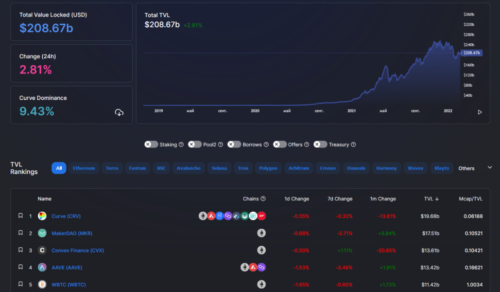Curve Finance is a DeFi protocol that doesn’t often grab the crypto news headlines. Nevertheless, it has already become the undisputed decentralized finance market leader by total value locked (TVL). We decided to take a closer look at the most popular DeFi system today.
DeFi protocol Curve Finance (Automated Market Maker Protocol, AMM) had an undeniably successful 2021, with its CRV governance token quietly rising to become one of the best of the year. This, despite the overwhelming craze over the SHIB coin and other dog-themed tokens.
Launched in August 2020, the CRV token is designed to incentivize liquidity providers on Curve Finance and encourage community participation. 5% of initial 1.3 billion CRV was distributed to liquidity providers before the token’s launch. The Ethereum community has responded to it by investing millions of dollars worth of stablecoins in the protocol.
DeFi market analysts attribute the success of CRV in 2021 to two main factors: its tokenomics and the rapid growth of a yield optimization protocol focused on Curve Finance, one of the largest AMMs on the Ethereum blockchain.
In 2021, decentralized finance went through an explosive growth period, and Curve Finance managed to “ride” the influx of money from investors and market participants better than most of their competitors. By the end of August, operating at that time in the Ethereum and Polygon networks, this decentralized exchange occupied 39.3% of the market, outperforming the popular Uniswap platform by a wide margin.
Today, Curve Finance ranks first among DeFi protocols.

Their TVL is $19.68 billion, $16.97 of which is on the Ethereum blockchain. In total, Curve Finance works with eight blockchains: Optimism, Avalanche, Harmony, Ethereum, Gnosis, Polygon, Arbitrum, Fantom.

The Curve Finance project has been running since January 2020. At first, it was a decentralized crypto exchange specializing in profitable stablecoin trade with minimal slippage and small commissions. Later, the platform got liquidity pools operating on the Compound protocol and designed for stablecoins.
Users are happy to invest in Curve Finance due to its lack of price fluctuation risks. Stablecoins are always in demand anyway, and fixing the exchange rate allows you to earn with equal success in growing and declining markets. With minimal risk, they provide a good return: as high as 10% yearly in some liquidity pools. For its CRV token (not a stablecoin), Curve Finance offers 9% annually.
There have been 445.17 million CRV tokens issued to date; its price at the time of this writing is $3.10, with the total capitalization of $1.38 billion. The token reached its peak price of $6.42 on January 4 this year. An ordinary user can obtain CRV in two ways: get it as a liquidity provider in Curve or buy the token on a crypto exchange.
Until August 2021, the liquidity generated in Curve was transferred into the Compound or yearn.finance protocols. Now, liquidity providers in Curve pools are rewarded with CRV tokens. This way, they can not only earn transaction fees but also benefit from other DeFi protocols (such as Compound, Yearn, Synthetix, RenBTC, etc.).
Curve uses the same automatic market maker (AMM) engine as Uniswap, with algorithms to mimic the trading behavior of traditional market makers and smart contracts to act as counterparties. At the same time, while Uniswap’s permanent market maker model works well, it is not ideal for some asset types. All major stablecoins are pegged to the price of $1. Although there are fluctuations, stablecoin trade should be more or less lossless in the long run. Based on this assumption, Curve developed the StableSwap market maker algorithm specifically for stablecoin transactions. And since their curve is smoother, stablecoin trading slippage can be lower than on Uniswap.
As long as someone trades on Curve, liquidity providers (LP) receive a transaction fee. As Curve’s transaction volume increases, LPs’ annual profit also increases. Lending tokens such as Compound provides additional interest, generating even more revenue than Curve transaction fees alone.
The platform was founded by physicist Mikhael Egorov. Before creating Curve, Mikhael used to invest in BTC (2013) and mine LTC. He also founded NuCypher, a company specializing in cryptography. Over time, NuCypher moved into blockchain project development, receiving $30 million during the 2018 ICO and another $20 million during a closed round of investments in 2019.
Since 2018, Mikhail Egorov has worked with DeFi protocols, starting with makerDAO. In 2019, he got into decentralized exchanges (DEX) but was dissatisfied with the existing solutions at the time, namely Uniswap. As a result, he created his own DEX project, StableSwap, in November 2019. In 2020, Egorov introduced Curve Finance.
But as attractive as Egorov’s DeFi protocol is, there are still various potential risks associated with it. Firstly, there are some questions regarding the history of the CRV token launch. Curve Finance DAO holds about 70% of the veCRV tokens, maintaining a monopoly on power in a “decentralized” organization. In addition, the creator of Curve Finance has sole decision-making authority in Curve Finance DAO, earning him criticism from both the community and his partners, including the creator of yearn.finance Andre Cronje.
There are also dangers associated with smart contracts. Although Curve went through a security audit, it happened back in 2020 and doesn’t eliminate the risk of errors. Finally, due to the current high fees on the Ethereum network, the charges are another factor to consider when dealing with Curve Finance.


